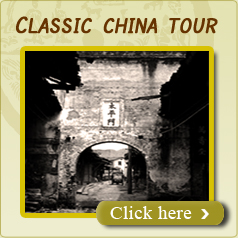Puning Temple

-
City Name:Chengde (Chinese:承德, Pinyin:Chengde)
-
Population :3400,000
-
Area :40,000 square km
-
Overview:Chengde is a famous historical and cultural city in China, located in the northeast of Hebei province, about 220 kilometers from Beijing. It was an imperial resort area in the Qing dynasty (1644-1911).
Puning Temple
Puning Temple is one of the famous Eight Outer Temples in Chengde city, Hebei Province, located to the north of the Mountain Resort. It was built in 1755 of the Qianlong reign to show the Qing's respect to the ethnic minorities. In 1994, Puning temple was listed as the world cultural heritage site together with the Mountain Resort.
 There is the world's tallest wooden sculpture of Bodhisattva Avalokiteśvara housed in the Puning Temple, which 21.85 meters in height and 110 tons in weight. The Bodhisattva Avalokiteśvara shows a thousand different eyes and a thousand different arms stretched out from its frame in various sizes. It is one of the famous large-scale wood-carved Buddha statues in China.
There is the world's tallest wooden sculpture of Bodhisattva Avalokiteśvara housed in the Puning Temple, which 21.85 meters in height and 110 tons in weight. The Bodhisattva Avalokiteśvara shows a thousand different eyes and a thousand different arms stretched out from its frame in various sizes. It is one of the famous large-scale wood-carved Buddha statues in China.
The main structures
Puning Temple is of grand scale, occupying an area of more than 23,000 square meters. It is composed of the Hall of Great Buddha, The Imperial Stele Pavilion (Yu Bei Ting), The Hall of Heavenly Kings (Tian Wang Dian), The Mahavira Hall (Da Xiong Bao Dian), The Mahayana Pavilion (Da Cheng Ge), The Walls of Ten Thousand Buddhas, Lama Pagodas, stone stairs, The Buddhist Academy .
 In the Mahavira Hall, the statues of the Eighteen Arhats feature different gestures, natural look, and smooth pleat lines. The skills are so exquisite that the statues look as if they were real and vivid. On the walls of Ten Thousand Buddhas in the Mahayana Pavilion, there are a large number of small mountain-like niches arranged in good order. Each niche houses a golden Buddha statue. The World's Largest Gold-plated Wood-carved Statue of Sahasra-bhuja Sahasra-netra Avalokitesvar, and lots of wonders in the temple make your trip unforgettable.
In the Mahavira Hall, the statues of the Eighteen Arhats feature different gestures, natural look, and smooth pleat lines. The skills are so exquisite that the statues look as if they were real and vivid. On the walls of Ten Thousand Buddhas in the Mahayana Pavilion, there are a large number of small mountain-like niches arranged in good order. Each niche houses a golden Buddha statue. The World's Largest Gold-plated Wood-carved Statue of Sahasra-bhuja Sahasra-netra Avalokitesvar, and lots of wonders in the temple make your trip unforgettable.
A brief history
In order to celebrate the suppression of rebellion of Junggar tribe, Emperor Qianlong invited the four troops that participated in the suppression to the Mountain Resort in October in the 20th year of the Qianlong reign. He dubbed leaders of the four troops, and ordered to build the Puning Temple.
>> Eight Outer Temples
 Outside the palace walls of the Mountain Resort, to the north and west, lies the Eight Outer Temples. They were built between 1713 and 1780, many of them are in Tibetan style. Actually, 'Eight Outer Temples' is a collective name given to 12 temples. These temples were administered by Lifan Yuan, an administrative department for the affairs of ethnic minorities such as the Mongolians and Tibetans, so different combinations of architectural style could be seen. Together with the Mountain Resort of Chengde, the Eight Outer Temples was made a UNESCO World Heritage Site in 1994.
Outside the palace walls of the Mountain Resort, to the north and west, lies the Eight Outer Temples. They were built between 1713 and 1780, many of them are in Tibetan style. Actually, 'Eight Outer Temples' is a collective name given to 12 temples. These temples were administered by Lifan Yuan, an administrative department for the affairs of ethnic minorities such as the Mongolians and Tibetans, so different combinations of architectural style could be seen. Together with the Mountain Resort of Chengde, the Eight Outer Temples was made a UNESCO World Heritage Site in 1994.
Now six temples are open to the tourists, which Putuo Zongchengzhi Temple, Puning Temple, Xumi Fushouzhi Temple, Pule Temple, Anyuan Temple, and Puyou Temple. Each shows unique features and special appeal. Of the eight temples that surround Chengde, two of the most famous are Puning Temple and Putuo Zongcheng Temple.





